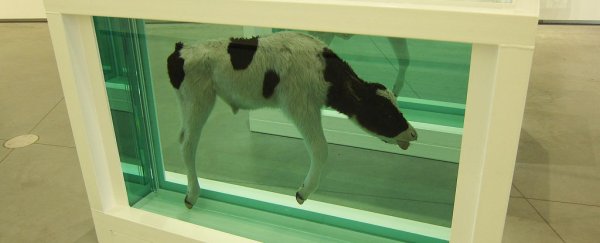Update: This paper has been retracted, see below.
A scandal has erupted over some of the most famous and divisive artworks of the 90s, with scientists claiming that British artist Damien Hirst's works involving dead animals preserved in tanks of formaldehyde are leaking harmful fumes.
A team led by Italian chemist Pier Giorgio Righetti was testing a new sensor for the remote detection of formaldehyde gas, and discovered faint traces of potentially harmful fumes around two of Hirst's artworks on show in a 2012 exhibition at the Tate Modern in London.
The two artworks in question were "Away from the Flock", a 1994 exhibit showing a preserved lamb, and "Mother and Child (Divided)", a 1993 piece featuring a bisected calf and cow spread over four tanks (one section of which you can see in the image above).
"It has been found that the tanks are surrounded by formaldehyde fumes, constantly exuded in the atmosphere (likely via the sealant), reaching levels of 5 ppm (parts per million), one order of magnitude higher than the 0.5 ppm limit set up by legislation," the researchers write in Analytical Methods.
But despite discovering the harmful chemicals, the researchers say they're so faint, they wouldn't pose a threat to visitors to the galleries who only stood in their presence for a short time. In the study, published online this month, the team also reports finding formaldehyde fumes around artworks at the Summer Palace in Beijing, China, which they attribute to new lacquers painted over the works.
Righetti told the AFP that his research "was intended to test the uses of a new sensor for measuring formaldehyde fumes and we do not believe that our findings suggest any risk to visitors at Tate Modern".
But while it seems like visitors temporarily viewing the artworks should be safe from harm, what about museum staff who were surrounded by the potentially leaking tanks indoors for much longer periods?
According to The Times, at least one gallery attendant has come forward complaining of health problems at the time of the exhibition.
"I'm quite alarmed," she told the newspaper. "I was in… poor health when I was at the exhibition, but we were working 60 hours a week, and on 12-hour shifts on the weekends, so I put it down to lack of sleep."
For its part, the museum says nobody should be worried.
"Tate always puts the safety of its staff and visitors first, and we take all necessary precautions when installing and displaying our exhibitions," a spokesperson for the Tate told the media. "These works contained a very dilute formaldehyde solution that was contained within sealed tanks."
A statement from Hirst's company, Science Ltd., also played down fears. "We do regular testing and our experts tell us that at the levels reported by this journal, your eyes would be streaming and you would be in serious physical discomfort," the statement reads. "No such complaints were made to us during the show – or at any other shows or sites featuring the formaldehyde works. We don't believe any risk was posed to the public."
Others in the art community are also claiming the controversy is a beat-up, and that the scientists' findings are coming more than three years after the exhibition, which means it's too late to do anything about it now.
"With all the risk and courage artists display, the least they can expect is a bit of guts from audiences in return. The truth is that a whiff of formaldehyde in the air can only add to art's appeal," writes art critic Jonathan Jones in The Guardian. "And now we can all say: I visited the Damien Hirst show in 2012 and lived to tell the tale."
Update: This paper has been retracted. More details here.
